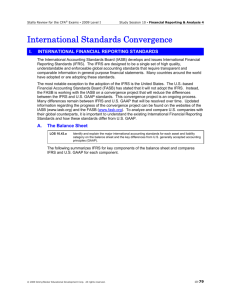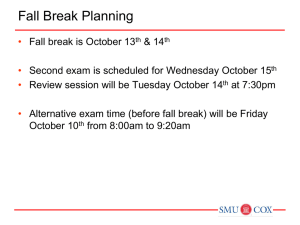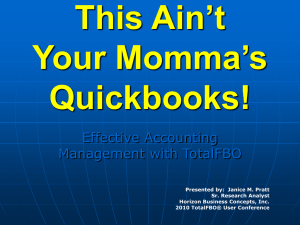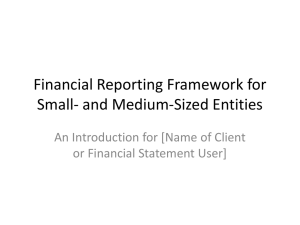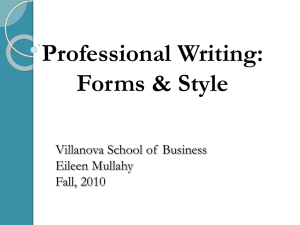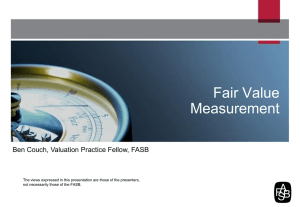Slides
advertisement
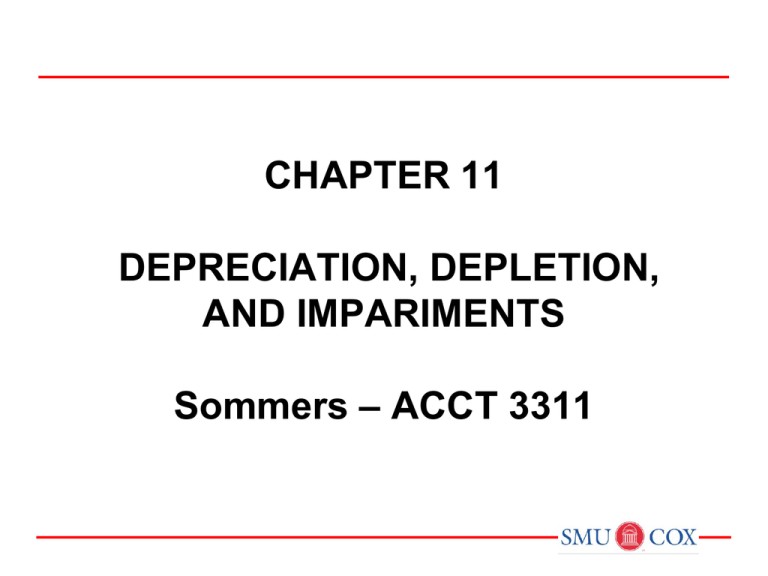
CHAPTER 11 DEPRECIATION, DEPLETION, AND IMPARIMENTS Sommers – ACCT 3311 Special Depreciation Methods Choice of method depends on nature of the assets involved: Group method used when the assets are similar in nature and have approximately the same useful lives. Composite approach used when the assets are dissimilar and have different lives. Companies are also free to develop tailor-made depreciation methods, provided the method results in the allocation of an asset’s cost in a systematic and rational manner (Hybrid or Combination Methods). Example 4: Group Depreciation Highsmith Rental Company purchased an apartment building early in 2011. There are 20 apartments in the building and each is furnished with major kitchen appliances. The company has decided to use the group depreciation method for the appliances. The following data are available: Appliance Cost ResVal ServLife Stoves $15,000 $3,000 6 Refrigerators 10,000 1,000 5 Dishwashers 8,000 500 4 Calculate the group depreciation rate and group life. Example 4: Continued Asset Stoves Refrigerators Dishwashers Totals Cost $15,000 10,000 8,000 $33,000 Residual Value $3,000 1,000 500 $4,500 Group depreciation rate Group life Depreciable Base $12,000 9,000 7,500 $28,500 Estimated Life(yrs.) 6 5 4 Depreciation per Year (straight line) Discussion Questions Q11–10 What are the major factors considered in determining what depreciation method to use? Impairments When the carrying amount of an asset is not recoverable, a company records a write-off referred to as an impairment. Events leading to an impairment: a. Significant decrease in the fair value of an asset. b. Significant change in the manner in which an asset is used. c. Adverse change in legal factors or in the business climate. d. An accumulation of costs in excess of the amount originally expected to acquire or construct an asset. e. A projection or forecast that demonstrates continuing losses associated with an asset. Measuring Impairments 1. Review events for possible impairment. 2. If the review indicates impairment, apply the recoverability test. If the sum of the expected future net cash flows from the long-lived asset is less than the carrying amount of the asset, an impairment has occurred. 3. Assuming an impairment, the impairment loss is the amount by which the carrying amount of the asset exceeds the fair value of the asset. The fair value is the market value or the present value of expected future net cash flows. Impairments Finite-life Assets to be Held and Used Step 1 – Recoverability • An asset is impaired when the undiscounted sum of its estimated future cash flows is less than its book value Step 2 – Measurement • Impairment loss is book value less fair value (Market value, price of similar assets, or PV of future net cash inflows) • Impairment loss is reported as part of income from continuing operations $0 Fair Value $125 Case 1: $50 book value. No loss recognized Undiscounted future cash flows $250 Case 3: $275 book value. Loss = $275 - $125 Case 2: $150 book value. No loss recognized Example 5: Asset Impairment Chadwick Enterprises, Inc., operates several restaurants throughout the Midwest. Three of its restaurants located in the center of a large urban area have experienced declining profits due to declining population. The company’s management has decided to test the operational assets of the restaurants for possible impairment. The relevant information for these assets is presented below. Book value $6.5 million Estimated undiscounted sum of future cash flows 4.0 million Fair value 3.5 million Determine the amount of the impairment loss, if any. Example 5: Continued Step 1: Step 2: Example 5b: Asset Impairment Chadwick Enterprises, Inc., operates several restaurants throughout the Midwest. Three of its restaurants located in the center of a large urban area have experienced declining profits due to declining population. The company’s management has decided to test the operational assets of the restaurants for possible impairment. The relevant information for these assets is presented below. Book value $6.5 million Estimated undiscounted sum of future cash flows 6.8 million Fair value 5.0 million Determine the amount of the impairment loss, if any. Example 5b: Continued Step 1: Example 6: Asset Impairment General Optic Corporation operates a manufacturing plant in Arizona. Due to a significant decline in demand for the product manufactured at the Arizona site, an impairment test is deemed appropriate. Management has acquired the following information for the assets at the plant: Cost $32,500,000 Accumulated depreciation 14,200,000 General’s estimate of the total cash flows to be generated by selling the products manufactured at its Arizona plant, not discounted to present value 15,000,000 The fair value of the Arizona plant is estimated to be $11,000,000. 1. Determine the amount of impairment loss, if any. 2. If a loss is indicated, where would it appear in General Optic’s multiple-step income statement? Example 6: Continued Assets Held for Sale • Assets held for sale include assets that management has committed to sell immediately in their present condition and for which sale is probable. Impairment loss = Book value Fair value less – cost to sell Depletion and Amortization Depletion of Natural Resources • As natural resources are “used up”, or depleted, the cost of the natural resources must be allocated to the units extracted. • The approach is based on the units-of-production method. Establishing a Depletion Base Computation of the depletion base involves four factors: (1) Acquisition cost. (2) Exploration costs. (3) Development costs. (4) Restoration costs. Example 7: Depletion At the beginning of 2011, Terra Lumber Company purchased a timber tract from Boise Cantor for $3,200,000. After the timber is cleared, the land will have a residual value of $600,000. Roads to enable logging operations were constructed and completed on March 30, 2011. The cost of the roads, which have no residual value and no alternative use after the tract is cleared, was $240,000. During 2011, Terra logged 500,000 of the estimated five million board feet of timber. Calculate the 2011 depletion of the timber tract and depreciation of the logging roads assuming the units-of-production method is used for both assets. Continuing Controversy Oil and Gas Industry has two acceptable accounting alternatives • Successful efforts method – Exploration costs resulting in unsuccessful wells (dry holes) are expensed. • Full-cost method – Exploration costs resulting in unsuccessful wells may be capitalized. Political pressure prevented the FASB from requiring all companies to use the successful efforts method. MACRS vs. GAAP Modified Accelerated Cost Recovery System MACRS differs from GAAP in three respects: 1. a mandated tax life, which is generally shorter than the economic life; 2. cost recovery on an accelerated basis; and 3. an assigned salvage value of zero. (Basically DDB with a half-year convention) IFRS vs. GAAP RELEVANT FACTS - Similarities The definition of property, plant, and equipment is essentially the same under GAAP and IFRS. Under both GAAP and IFRS, changes in depreciation method and changes in useful life are treated in the current and future periods. Prior periods are not affected. GAAP recently conformed to IFRS in this area. The accounting for plant asset disposals is the same under GAAP and IFRS. The accounting for the initial costs to acquire natural resources is similar under GAAP and IFRS. Under both GAAP and IFRS, interest costs incurred during construction must be capitalized. Recently, IFRS converged to GAAP. IFRS vs. GAAP RELEVANT FACTS - Similarities The accounting for exchanges of nonmonetary assets has recently converged between IFRS and GAAP. GAAP now requires that gains on exchanges of nonmonetary assets be recognized if the exchange has commercial substance. This is the same framework used in IFRS. GAAP also views depreciation as allocation of cost over an asset’s life. GAAP permits the same depreciation methods (straight-line, diminishing-balance, units-of-production) as IFRS. IFRS vs. GAAP RELEVANT FACTS - Differences IFRS requires component depreciation. Under GAAP, component depreciation is permitted but is rarely used. Under IFRS, companies can use either the historical cost model or the revaluation model. GAAP does not permit revaluations of property, plant, and equipment or mineral resources. In testing for impairments of long-lived assets, GAAP uses a twostep model to test for impairments. As long as future undiscounted cash flows exceed the carrying amount of the asset, no impairment is recorded. The IFRS impairment test is stricter. However, unlike GAAP, reversals of impairment losses are permitted. Example 8: GAAP vs. IFRS Depreciation On June 30, 2011, Rosetta Granite purchased a machine for $120,000. The estimated useful life of the machine is eight years and no residual value is anticipated. An important component of the machine is a specialized highspeed drill that will need to be replaced in four years. The $20,000 cost of the drill is included in the $120,000 cost of the machine. Rosetta uses the straight-line depreciation method for all machinery. Calculate depreciation for 2011 and 2012 applying the typical U.S. GAAP treatment. Repeat applying IFRS. Example 8: Continued • U.S. GAAP • IFRS:
